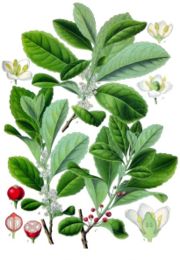Yerba maté
| Ilex paraguariensis subsp. var. | ||||||||||||||||||||||||||||||||||||||||||||||||||||||||
|---|---|---|---|---|---|---|---|---|---|---|---|---|---|---|---|---|---|---|---|---|---|---|---|---|---|---|---|---|---|---|---|---|---|---|---|---|---|---|---|---|---|---|---|---|---|---|---|---|---|---|---|---|---|---|---|---|

|
|
| ||||||||||||||||||||||||||||||||||||||||||||||||||||||
| ||||||||||||||||||||||||||||||||||||||||||||||||||||||||
Yerba mate or yerba-mate (Br.) (Template:Lang-es, Template:Lang-pt), Ilex paraguariensis, is a species of holly (family Aquifoliaceae) native to subtropical South America in northeastern Argentina, Bolivia, Paraguay and southern Brazil.[1] It was first scientifically classified by Swiss botanist Moses Bertoni, who settled in Paraguay in 1895.
The yerba mate plant is a shrub or small tree growing up to 15 meters tall. The leaves are evergreen, 7–11 cm long and 3–5.5 cm wide, with a serrated margin. The flowers are small, greenish-white, with four petals. The fruit is a red drupe 4–6 mm in diameter.[2]
| Standard Cyclopedia of Horticulture |
|---|
|
Ilex paraguariensis, St. Hil. (I. paraguensis, Don). Shrub or small tree, to 20 ft.: branchlets glabrous or puberulous: lvs. obovate to obovate-oblong or elliptic-oblong, narrowed at the base, obtuse or short and obtusely acuminate, crenate-serrate, glabrous or pubescent below, 3-5, rarely to 10 in. long: fls. axillary, fascicled or in stalked cymes: fr. globose or ovoid, 1/5 – ¼ in. across, red or reddish brown. Brazil.
The above text is from the Standard Cyclopedia of Horticulture. It may be out of date, but still contains valuable and interesting information which can be incorporated into the remainder of the article. Click on "Collapse" in the header to hide this text. |
Cultivation
Propagation
Pests and diseases
Varieties
Gallery
-
Yerba mate growing in the wild.
-
photo 1
-
photo 2
-
photo 3
References
- ↑ Template:IUCN2006
- ↑ Yerba mate — what? at Ushuaia.pl.
- Standard Cyclopedia of Horticulture, by L. H. Bailey, MacMillan Co., 1963
External links
- w:Yerba maté. Some of the material on this page may be from Wikipedia, under the Creative Commons license.
- Yerba maté QR Code (Size 50, 100, 200, 500)

